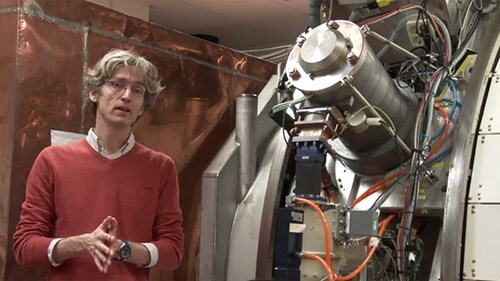The new Center for Image Sciences (CIS) of the University Medical Center (UMC) Utrecht, the Netherlands, is the first in the world to feature a high-field MR-LINAC system – a potential gamechanger in highly targeted, tissue-saving radiotherapy. The CIS, inaugurated on 22 January 2015, was built with a 40 million euro investment and will host a number of clinical trials of the MR-LINAC system. * The MR-LINAC is considered work in progress, not CE marked, and not available for sale. The MR-LINAC will be brought to market by Elekta.
Quantum leap in radiotherapy
The MR-LINAC system is being developed to capture detailed MR images of tumors and surrounding tissues while the patient receives radiotherapy. This would enable doctors to visualize soft tissue structures during radiation therapy, with the ultimate objective to adapt treatment delivery in realtime for precise cancer treatments.
Success through collaboration
The Elekta-led research project to develop the MR-LINAC, also involving UMC Utrecht and Philips, began over a decade ago. In 2012, the collaboration was expanded into the MR Linac Research Consortium, still with Elekta at the helm, which currently consists of seven highly specialized cancer research and treatment institutes around the world, with Philips as the MRI technology partner. The MR-LINAC system installed in Utrecht is the first high-field MR-LINAC system in the world and is equipped with powerful, state-of-the-art hardware for both the LINAC and the MRI: a linear accelerator from Elekta and a modified 1.5 T MRI module from Philips. The modified MRI module is based on hardware also used in Philips MRI scanners for diagnostic imaging and treatment planning.
MR-LINAC developers talk about the promise the system offers and how this technology can offer more precise radiation therapy. (Source: UMC Utrecht.)
Gene Saragnese, CEO Imaging at Philips Healthcare, says:
This is an exciting development that could benefit many current and future cancer patients. Cancer is a major global disease that we hope to control with more targeted treatments. MRI is emerging in oncology applications because of its excellent real-time 3D visualization of soft tissue. Together with our partners, all leaders in radiation therapy delivery, we are convinced that the integrated MRI-guided radiation therapy system has the potential to become a game changer in cancer care on a global scale.”
Niklas Savander, President and CEO of Elekta, also has high expectations:
We expect that high-field MRI-guided radiation therapy will become the standard of care within the next 10 years.”
Cancer centers involved in the consortium
The University Medical Center Utrecht (Utrecht, the Netherlands), The University of Texas MD Anderson Cancer Center (Houston, Texas), The Netherlands Cancer Institute-Antoni van Leeuwenhoek Hospital (Amsterdam, the Netherlands), Sunnybrook Health Sciences Centre (Toronto, Ontario), The Froedtert & Medical College of Wisconsin Cancer Center (Milwaukee, Wisconsin), the Christie NHS Foundation Trust (Manchester, UK) and The Institute of Cancer Research, working with its clinical partner The Royal Marsden NHS Foundation Trust (London, England).
Unique therapeutic setup
The consortium will investigate whether the use of MRI imaging at the time of treatment results in increased accuracy of the placement of the dose, reducing the need for large safety margins around the tumor target. It is expected that the real-time images of both tumors and surrounding organs, provided by the integrated MR-guided radiation therapy system, would enable doctors to see more precisely what they are treating, and irradiate the tumor as it moves in the body during treatment. These targets are typically going to be in anatomy that changes its position and shape either from day to day or during the treatment. Incisionless treatment approaches are less invasive for the patient, and potentially provide gentler treatment, with fewer side effects and potential for better outcomes. Many of the world’s top radiation therapy centers have expressed interest in the technology.

The future of MR-LINAC
The new Center for Imaging Sciences features the first complete high-field MR-LINAC system. Both the MRI and the Linac are complex, sensitive systems, and extensive innovation was needed to ensure reliable operation in tandem: the radiation beam needs to pass right through a gap in the specially developed MRI magnet. The system is currently undergoing technical testing, and clinical testing will start once the system is released for this.
For more information
Watch the Elekta webcast from the opening of the CIS, including interviews with the various parties involved in the MR-LINAC project.




